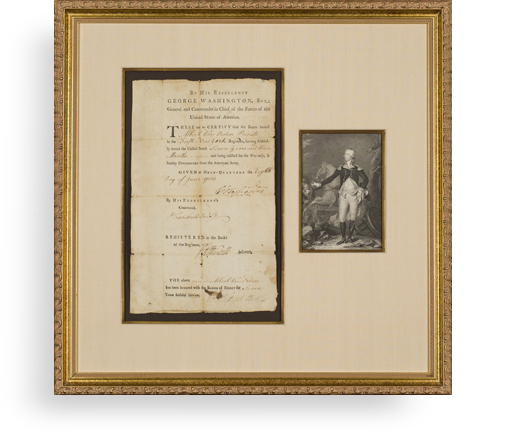Secretary of State Thomas Jefferson, Himself a Noted Inventor, Provides Official Notice of Passage of the Patent Act of 1790, Which Effectuated Article I, Section 8 of the U. S. Constitution

The act was the first Intellectual Property statute of the United Sates, and gave inventors the “sole and exclusive right and liberty of making, constructing, using and vending to others to be used" their works.
Jefferson was a member of the first Patent Board and is considered “the first administrator of the American patent system and the first patent examiner”
Patents as a way for government to promote innovation by rewarding an inventor with a monopoly on his or her invention for a limited term predate the...
Jefferson was a member of the first Patent Board and is considered “the first administrator of the American patent system and the first patent examiner”
Patents as a way for government to promote innovation by rewarding an inventor with a monopoly on his or her invention for a limited term predate the founding of the United States. The English Statute of Monopolies of 1623 provided an exception to its general condemnation of monopolies by providing the “true and first inventor” of a new manufacture up to fourteen years of exclusivity. The Founding Fathers considered the development of inventions so important that the new Constitution specifically provided at Article I, Section 8, that Congress had the power “to promote the Progress of Science and the useful Arts, by securing, for limited Times, to Authors and Inventors, the exclusive Right to their respective Writings and Discoveries.” As the terms were used at that time, “science” referred to knowledge, and the “useful arts” generally meant the work of skilled workers and artisans, especially in the fields of engineering and manufacturing. Today we might call it technology.
The First Congress took up the work of implementing the Constitution, and early in its second session passed “An Act to promote the progress of useful Arts”, which is commonly known as the Patent Act of 1790. It was just the tenth major act of Congress, and President Washington signed it into law on April 10, 1790. This was the United States' first intellectual property statute, and it applied to anyone who invented or discovered any useful art, manufacture, engine, machine, or device, or any improvement therein. It granted the applicant the "sole and exclusive right and liberty of making, constructing, using and vending to others to be used" of his invention, for a period of fourteen years.
The act set up Patent Board members, who were known as the “Commissioners for the Promotion of Useful Arts.” They were given the authority to grant or refuse a patent after deciding if the invention or discovery was “sufficiently useful and important.” The first board members were the Secretary of State, the Secretary of War, and the Attorney General, which meant Thomas Jefferson, Henry Knox, and Edmund Randolph constituted the first Patent Board.
During the Washington administration, the Secretary of State was required to certify to the governors of the states that acts, bills and resolutions had been officially passed. Here Secretary of State Jefferson provides such official notice to a state governor of this first intellectual property statute.
Letter Signed, New York, April 15, 1790, to the governor of one of the 12 states then having ratified the new U.S. Constitution. “I have the honor to send you herein enclosed two copies duly authenticated of the Act to promote the progress of the useful arts, and of being with sentiments of the most perfect respect, Your Excellency’s Most Obedient & most humble servant, Thomas Jefferson.” Our research indicates that it has been almost 2 decades since the last notification letter for this act, signed by Jefferson, came up at public sale.
Fifty-seven patents were granted during the three years this initial Patent Act was in effect. Three of these patents were granted in 1790, thirty-three in 1791, eleven in 1792, and ten in 1793 (before February, which is when the act was amended so that inventions no longer needed to be deemed as “sufficiently useful and important” to be granted a patent.
This act was of particular interest to Jefferson, as he was himself a noted inventor, with over a dozen inventions to his name. Among other things, he invented an important improvement for the plow and a copying machine called a polygraph. On the Board, he saw the patent applications first, and the U.S. Patent and Trademark Office considers Jefferson “the first administrator of the American patent system and the first patent examiner”. However, he was concerned about the monopoly created by patents and used his position to introduce strict standards for their granting.

Frame, Display, Preserve
Each frame is custom constructed, using only proper museum archival materials. This includes:The finest frames, tailored to match the document you have chosen. These can period style, antiqued, gilded, wood, etc. Fabric mats, including silk and satin, as well as museum mat board with hand painted bevels. Attachment of the document to the matting to ensure its protection. This "hinging" is done according to archival standards. Protective "glass," or Tru Vue Optium Acrylic glazing, which is shatter resistant, 99% UV protective, and anti-reflective. You benefit from our decades of experience in designing and creating beautiful, compelling, and protective framed historical documents.
Learn more about our Framing Services








































































































